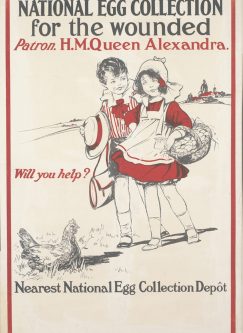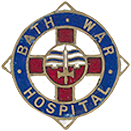National Egg Collection
A national egg collection for wounded soldiers and sailors was launched in November 1914 following a proposal put forward by Frederick Carl, the editor of Poultry World. The initial aim was to send fresh eggs to the wounded in hospital in Boulogne, with a target set at 20,000 a week. This was quickly surpassed, and by August 1915 over a million eggs were received, a figure that did not include those sent directly to local hospitals.
It would seem that Bath was a little slow to get involved in this endeavour, but the imminent opening of the War Hospital galvanised the local population into action. In January 1916 the Bath Chronicle announced that Mrs Percy Stothert was to organise the egg collection, with premises in St. James’s Parade put at her disposal for the receiving and packing of eggs. The Egg Committee undertook to supply the War Hospital with 2 eggs per week per head for every man in the hospital. In April 1918 the Bath Chronicle reported that the parish of St. John’s, Lower Weston had donated 16,271 eggs since July 1916.
The British Royal family sought to distance itself from its German relations during WW1, and worked hard to develop a more personal relationship with the British public through their charity work. They made visits to the many charitable organisations set up during the war, meeting troops and volunteers, making personal appeals and lending their names as patrons. Queen Alexandra was patron of the National Egg Collection, and the resulting publicity helped boost the cause.

Poster from Imperial War Museum of children collecting eggs
The National Egg Collection appealed to all classes and ages, and was particularly popular with children. They were targeted in promotional posters and made to feel that they were ‘doing their bit’ for the war effort. In May 1917 the Bath Chronicle reported that the girls of Upper Weston School had donated 112 eggs ‘as the result of self denial’, and that one girl had made badges, which she sold, and bought eggs with the proceeds.
Donors were encouraged to write their names and addresses on the eggs, along with a cheering message, and many soldiers would write and thank the donor for their gift. Kathleen Ainsworth tells the story of how one mischievous patient, who was on breakfast duty,
‘took it into his head to write (as is frequently done) some tender messages on each one, with a purely fictitious name and address. Two of the men wrote letters to the imaginary donors (girls of course) and what will happen I don’t know’.
The Bath War Hospital also kept chickens to supplement the egg supply, and this produced a rather unusual star – Griselda the hen.
The Matron of the hospital, Miss Amy Hill, wrote this account of Griselda’s arrival.
‘She came one day with five other hens for the purpose of laying eggs for the patients. Whether they all realised what was their mission in life I cannot say, but undoubtedly Griselda did, for she was no sooner inside the Hospital gates than she deposited her first egg with an air of determination to waste no time in “doing her bit”.


Bath War Hospital Postcards – Griselda The Hen
Miss Hill goes on to describe how Griselda soon became quite at home in her new surroundings, but seem concerned that her eggs were not being consumed by the wounded heroes’ for whom she laid them, and decided to visit the wards and lay her eggs beside the patients’ bedsides. In spite of efforts by some of the nurses to shoo her away and lock her out of the ward, Griselda always found her way back in, and for a time ‘adopted’ one particular wounded Tommy who had a cage over his wounded leg that must have seemed something like a hen-house. Griselda favoured this soldier until he was up and mobile again, and never made a special friend again, but she continued to visit anyone who she felt needed her. Matron Hill remembers her for ‘her quaint but kindly manners, her graceful form, her pretty speckled feathers, and above all, her lovely white eggs’. She concludes that Griselda has endeared herself ‘to many hearts and certainly to mine’.
